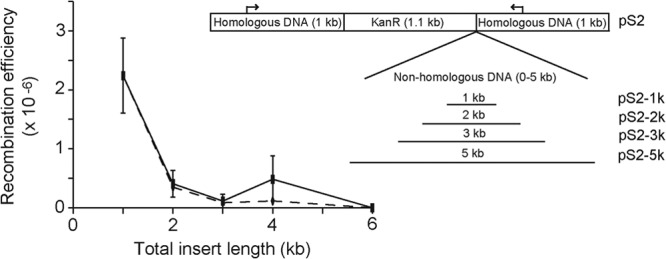Fig 2.

Recombination efficiencies of plasmids with nonhomologous inserts of different lengths ranging from 1 to 6 kb. Solid lines and squares show the recombination efficiencies (number of recombinants per total number of cells present) after normalization for the total number of transforming DNA units present. Dotted lines and empty diamonds show the overall recombination efficiencies. No recombinants were recovered when the total insert length was 6 kb. The image on the right depicts the region cloned into the vector backbone pGEM-5zf(+) to create the plasmids. The flanking region size was kept constant at approximately 1 kb on either side. The nonhomologous insert region consisted of a kanamycin resistance cassette (approximately 1.1 kb) and 0 to 5 kb of DNA amplified from a plant virus with no regions of homology to the X. fastidiosa genome (the total insert size for pS2 is approximately 1 kb, that for pS2-1k is approximately 2 kb, etc.). Arrows over the homologous DNA regions show the locations of primers rpfF-fwd and rpfF-rev, which were used to screen antibiotic-resistant colonies for proper insertion of the kanamycin resistance cassette and nonhomologous DNA.
